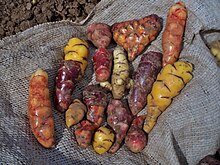酢浆薯
| 酢浆薯 | |
|---|---|

| |
| 黄色及紫色的酢浆薯 | |
| 科学分类 | |
| 界: | 植物界 Plantae |
| 演化支: | 维管植物 Tracheophyta |
| 演化支: | 被子植物 Angiosperms |
| 演化支: | 真双子叶植物 Eudicots |
| 演化支: | 蔷薇类植物 Rosids |
| 目: | 酢浆草目 Oxalidales |
| 科: | 酢浆草科 Oxalidaceae |
| 属: | 酢浆草属 Oxalis |
| 种: | 酢浆薯 O. tuberosa
|
| 二名法 | |
| Oxalis tuberosa | |
酢浆薯(Oxalis tuberosa)是多年生草本植物 ,以地下块茎越冬。 这些块茎在克丘亚语称为uqa, [1]西班牙语称oca或cubio,还有其他别名,例如新西兰山药 。 酢浆薯在安第斯山脉中部和南部种植,以取其块茎食用。野外并未发现这种植物,但在安第斯山脉中部有四个地区发现带有较小块茎之酢浆草属植物。 [2]酢浆薯在1830年传入欧洲,作为马铃薯的竞争植物,于1860年传入纽西兰 。
在纽西兰,酢浆薯已成为常见的蔬菜,被简称为山药或新西兰山药(尽管并非真正的山药 )。 它有多种颜色可供选择,包括黄色,橙色,粉红色,杏色和传统红色。 [3]

食用[编辑]
酢浆薯主要食用部位为块茎。但叶和嫩芽也可以作为绿色蔬菜食用。 成熟的块茎可以如同大黄一般使用。 [4]安第斯地区有各种加工和准备块茎的方法,在墨西哥,酢浆薯可与盐,柠檬和辣椒一起食用。 [3]风味通常略带浓烈,但不同品种之间的风味差异很大,有些根本不会酸。 [5]未煮熟时质地松脆(如胡萝卜 ),完全煮熟后质地如同淀粉或粉状。
酢浆薯的草酸盐含量很高,集中在块茎的皮。 [6]不同品种之间草酸盐浓度差异甚大,安第斯地区农民依此将酢浆薯分为两种使用。 [2]
一种称为酸酢浆薯,含有高量草酸。 [2]农民将块茎加工以便储存,在盖丘亚语中称为khaya 。 [7]首先将块茎浸入水中约一个月。 然后在炎热晴天,寒冷夜晚下,置于室外直到完全脱水为止。 在盖丘亚语中,此用途的栽培品种在被称为khaya (干燥后之产品的名称)或p'usqu (酸/发酵), 在艾马拉语中称为luk'i 。
另一类称为甜酢浆薯,草酸盐含量较低。 [2]传统安第斯地区使用方式,是在阳光下曝晒以减少有机酸(草酸)含量,而增加甜味。
每100公克营养 |
新鲜 | 干燥 |
|---|---|---|
| 热量 | 255 kJ(61 kcal) | 1,360 kJ(330 kcal) |
| 水 (克) | 84.1 | 15.3 |
| 蛋白质 (克) | 1.0 | 4.3 |
| 碳水化合物 (克) | 13.3 | 75.4 |
| 灰分 (g) | 1.0 | 3.9 |
| 钙 (毫克) | 2 | 52 |
| 磷 (mg) | 36 | 171 |
| 铁 (毫克) | 1.6 | 9.9 |
| 视黄醇 (微克) | 1个 | 0 |
| 核黄素 (毫克) | 0.13 | 0.08 |
| 烟酸 (毫克) | 0.43 | 0.85 |
| 维生素C (毫克) | 38.4 | 2.4 |
曝晒后的酢浆薯可以水煮、烘烤或油炸。在安第斯山脉地区,它就像马铃薯一样被用于炖菜和汤中,也可以用作甜点。这类品种在盖丘亚语中被称为Wayk'u (煮沸), misk'i (甜/美味),在艾马拉语被称为q'ini 。 [2]
酢浆薯含有碳水化合物 , 膳食矿物质和蛋白质 。 [8][9]品种之间的营养成分差异很大。
种植[编辑]


由于易于繁殖,且能耐受贫瘠的土壤,高海拔地区和恶劣的气候,因此酢浆薯是安第斯高地的重要主食作物之一[3]。
分布[编辑]
本物种原生于阿根廷西北方、玻利维亚、哥伦比亚、厄瓜多尔、秘鲁。并为委内瑞拉所引入栽植[10]。
种下分类元[编辑]
- Oxalis tuberosa subsp. unduavensis (Rusby) Lourteig
同物异名[编辑]
- Acetosella crassicaulis (Zucc.) Kuntze
- Acetosella crenata (Jacq.) Kuntze
- Acetosella tuberosa (Molina) Kuntze
- Oxalis aracatcha Zucc.
- Oxalis arracacha G.Don
- Oxalis chicligastensis R.Knuth
- Oxalis crassicaulis Zucc.
- Oxalis crenata Jacq.
- Oxalis melilotoides var. argentina Griseb.
- Xanthoxalis crassicaulis (Zucc.) Small
- Xanthoxalis tuberosa (Molina) Holub
参考文献[编辑]
- ^ Teofilo Laime Ajacopa, Diccionario Bilingüe Iskay simipi yuyayk'ancha, La Paz, 2007 (Quechua-Spanish dictionary)
- ^ 2.0 2.1 2.2 2.3 2.4 Bradbury, E.J.; Emshwiller, E. The Role of Organic Acids in the Domestication of Oxalis tuberosa: A New Model for Studying Domestication Resulting in Opposing Crop Phenotypes. Econ Bot. 2011, 65 (1): 76–84. doi:10.1007/s12231-010-9141-0.
- ^ 3.0 3.1 3.2 National Research Council (U.S.). Advisory Committee on Technology Innovation. Lost Crops of the Incas: Little-known Plants of the Andes with Promise for Worldwide Cultivation. National Academies. 1989: 83–92 [2020-04-08]. ISBN 0-309-04264-X. NAP:14292. (原始内容存档于2021-04-28).
- ^ Oca: Pie. 2014-07-26 [2020-04-08]. (原始内容存档于2021-04-27).
- ^ Oca: What does it taste like?. 2015-03-26 [2020-04-08]. (原始内容存档于2021-04-07).
- ^ Albihn, P. B. E.; Savage, G. P. The effect of cooking on the location and concentration of oxalate in three cultivars of New Zealand-grown oca (Oxalis tuberosa Mol). Journal of the Science of Food and Agriculture. 2001, 81: 1027–1033. doi:10.1002/jsfa.890.
- ^ Emshwiller, E. 2006. Evolution and conservation of clonally propagated crops: Insights from AFLP data and folk taxonomy of the Andean tuber oca (Oxalis tuberosa). Pages 308–346 in T. J. Motley, N. Zerega, and H. Cross, eds., Darwin’s Harvest: New Approaches to the Origins, Evolution, and Conservation of Crops. Columbia University Press, New York.
- ^ Hermann, M., & Erazo, C. (2000). Compositional changes of oca tubers following post-harvest exposure to sunlight. CIP Program Report, 391–396.
- ^ King, S.R.; Gershoff, S.N. Nutritional evaluation of three underexploited Andean tubers: Oxalis tuberosa (Oxalidaceae), Ullucus tuberosus (Basellaceae), and Tropaeolum tuberosum (Tropaeolaceae). Econ Bot. 1987, 41 (4): 503–511. doi:10.1007/BF02908144.
- ^ Oxalis tuberosa Molina | Plants of the World Online | Kew Science. Plants of the World Online. [2020-04-09]. (原始内容存档于2019-07-29).
